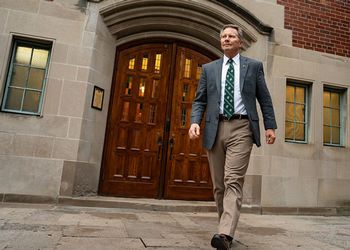Feature: MSU Researchers Focus on Understanding Nature's Conflicts

Cross-disciplinary teams of MSU researchers are gaining national and international recognition for their insights into the critical challenges between humans and animals such as pandas and tigers.
For the average person, the sheer complexity of how humans, animals, and plants interact in their environment is almost mind-numbing. Every element in the big picture is inextricably connected to and affected by every other element, from the molecular level to the cosmos. And every creature and plant has a role to play.
“We have to better understand nature’s interdependencies if we hope to find sustainable solutions that both benefit the environment and enable people to thrive,” says Jianguo “Jack” Liu, who holds the Rachel Carson Chair in Sustainability and is director of MSU’s Center for Systems Integration and Sustainability.
“Our new field of coupled human and natural systems offers us a more integrated way to look at the world, by bringing together the best minds from ecology, socioeconomics, demography, and other disciplines to study ecological sustainability on a local, national and global scale.”
Take the panda, for instance.
Scientists from MSU and the Chinese Academy of Sciences have developed forecasts of how changing climate may affect the most common species of bamboo that carpets the forest floors of prime panda habitat in northwestern China. Even the most optimistic scenarios show that bamboo die-offs would effectively cause prime panda habitat to become inhospitable by the end of the 21st century.
Bamboo is a vital part of forest ecosystems, being not only the sole menu item for giant pandas, but also providing essential food and shelter for other wildlife, including other endangered species like the ploughshare tortoise and purple-winged ground-dove. Bamboo has an unusual reproductive cycle and can be a risky crop on which to stake survival. The species studied only flower and reproduce every 30 to 35 years, which limits the plants’ ability to adapt to changing climate and can spell disaster for a food supply.
The pandas’ fate will be at the hands of not only nature, but also humans. If, as the study’s models predict, large swaths of bamboo become unavailable, human development prevents pandas from a clear, accessible path to the next meal source.
“The giant panda population also is threatened by other human disturbances,” says Mao-Ning Tuanmu, who recently finished his doctoral studies at MSU’s Center for Systems Integration and Sustainability and is now at Yale University. “Climate change is only one challenge for the giant pandas. But on the other hand, the giant panda is a special species. People put a lot of conservation resources into them compared to other species. We want to provide data to guide that wisely.”
Then there is the less attractive, but no less troubled, Baird’s tapir.
It’s estimated that about 4,500 Baird’s tapirs still exist in the world today, most of which live in Central and South America. Their numbers have been declining steadily due to human encroachment into their environment.
In fact, until recently the tapirs were thought to be extinct in the rainforests of Nicaragua. Now that they are thriving again, the 600-pound browsers are aggravating local farmers, who say the tapirs are eating their crops.
An MSU team, led by Lyman Briggs College Assistant Professor Gerald Urquhart, plans to capture a number of the animals and place GPS collars on them to monitor their movements. Urquhart is a member of CHANS-Net, the International Network of Research on Coupled Human and Natural Systems, which is coordinated by MSU’s Center for Systems Integration and Sustainability and sponsored by the Dynamics of Coupled Natural and Human Systems program of the National Science Foundation.
“We’d like to figure out how and where they live and if they can co-exist with the agricultural community,” Urquhart says. “Despite being considered a nuisance by the farmers, the animal plays a major role in seed dispersal—eating fruits and spreading seeds throughout the region.”
But the problem of wilder wildlife, like tigers, can be the ultimate challenge.
When you move from thinking about the “cow of the rainforest,” as Nicaraguans describe Baird’s tapir, to tigers in Nepal or wolves in Michigan, human tolerance becomes the central question in the balance of life.
“People have complex psychological relationships with wildlife,” says Neil Carter, researcher in MSU’s Center for Systems Integration and Sustainability. “Picking apart these complex relationships is the best way to get a really good idea of what’s affecting their tolerance of the animal.”
Carter has conducted research in Nepal’s Chitwan National Park, home to some 125 adult tigers that live close to people. And tigers, like all wild animals, have little regard for borders or fences. Likewise, the tigers’ human neighbors depend on the forests for their livelihoods. Conflict is inevitable. There were 65 human deaths due to tiger attacks from 1998 to 2006 and tigers are known to kill livestock. People sometimes kill tigers in response to these threats.
After surveying 500 people living near Chitwan about how they feel about future tiger population size and factors that may influence preferences, like past interactions with tigers as well as beliefs and perceptions about tigers, Carter developed a novel tool to help figure out where to direct conservation resources—not just in Nepal, but also for conserving carnivores that live next to people in many regions of the world.
The research is unique in that it explores peoples’ attitudes about protected animals. Work has been done to understand how people feel about their wildlife neighbors, such as deer or coyotes. But the relationship with protected animals, especially those that can be dangerous, is more complicated. Issues of fear, risk and control make for a volatile mix, as do the constraints on solutions.
“You can’t just remove all the tigers, or the grizzly bears or other carnivores that may pose a risk to people,” says Carter. “Managing animal populations in this fashion is not a viable option for protected species. It’s imperative to come up with ways that people and carnivores can get along.”
And in a way, tigers and humans are getting along. Carter found in another recent study that tigers and people are sharing exactly the same space—such as the same roads and trails—except tigers are doing it under the cover of darkness.
Carter spent two seasons setting motion-detecting camera traps for tigers, their prey, and people who walk the roads and trails of Chitwan, both in and around the park. Tigers typically move around at all times of the day and night, monitoring their territory, mating and hunting. But in the study area, Carter and his colleagues discovered that the tigers had become creatures of the night. The camera’s infrared lights document a pronounced shift toward nocturnal activity.
“It’s a very fundamental conflict over resources,” Carter notes. “Tigers need resources, people need the same resources. If we operate under the traditional wisdom that tigers only can survive with space dedicated only for them, there would always be conflict.”
And that’s why simple zoning solutions may not work.
Setting aside such dedicated spaces to keep animals and humans apart, or “zoning,” is becoming a common strategy to balance environmental protection and human needs. But another recent MSU study shows zoning for conservation demands reality checks.
“Zoning everywhere, in China and in the United States, is about drawing lines on a piece of paper,” says Vanessa Hull, a fisheries and wildlife doctoral candidate and a member of the Center for Systems Integration and Sustainability. “But the big challenge is always how do you bring those lines to life? Lines on a map don’t show up in a forest, laws mean little without enforcement, and animals can’t read zoning ordinances.”
Hull has spent years periodically living in the Wolong Nature Reserve in southwestern China to understand the delicate balance between pandas and the people who live amongst them. Pandas are picky about their habitat—needing gentle slopes, moderate elevation, and plenty of bamboo to munch. While other species that contribute to Wolong’s rich biodiversity benefit from conservation efforts, the charismatic pandas drive much of the policy there.
Wolong has been zoned into three areas: The “core” area strictly confines human activity to limit human impact on pandas. The “experimental” area thrives with homes, businesses, and roads. In between is a “buffer zone” of limited human access intended to acknowledge that it’s hard to declare a forest pristine if a hotel is right next door.
“We’re finding that you should have zoning in your toolbox to conserve habitat, but it shouldn’t be the only tool you have,” Hull says. “It needs to be paired with other policies when it comes to human behavior. We know that it is crucial to work directly with people and provide benefits to people to preserve habitat.”
Sue Nichols, ’84, assistant director of the Center for Systems Integration and Sustainability, handles strategic communication and outreach. She has 19 years of experience in science communication. Prior to joining the center in 2010, she was the marketing and communications director of the Michigan Memorial Phoenix Energy Institute at the University of Michigan and before that, she was MSU’s chief science writer.



